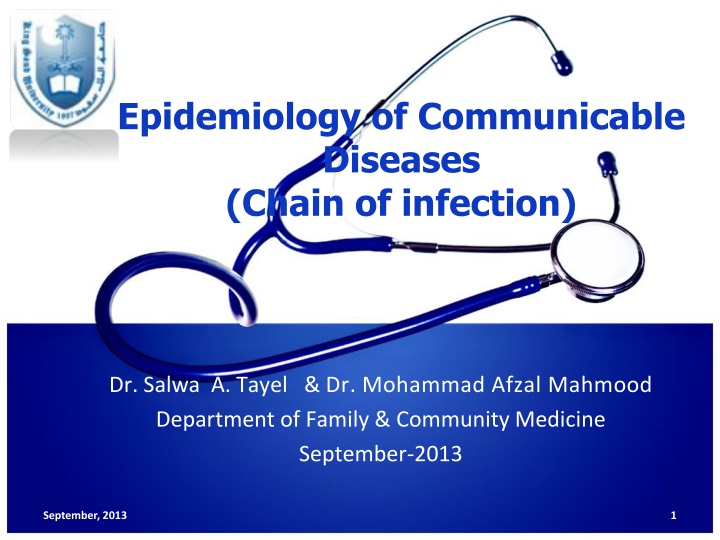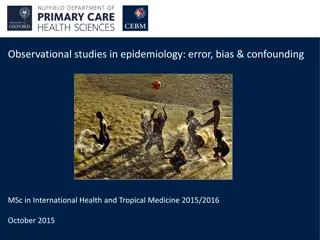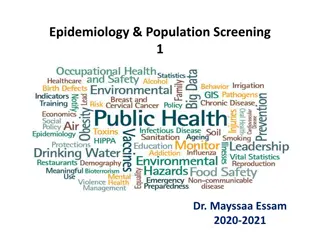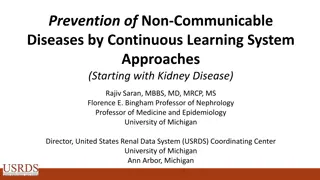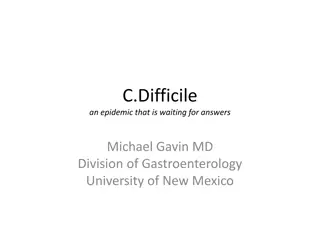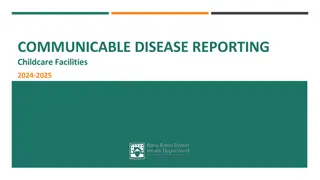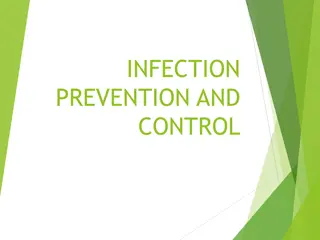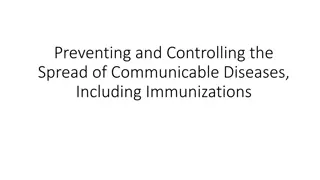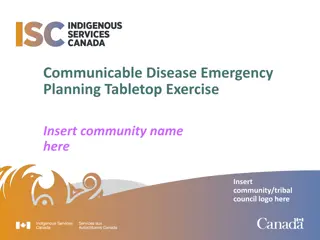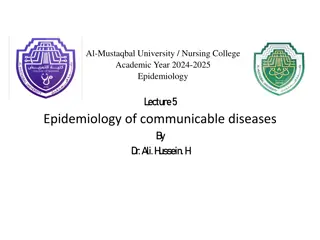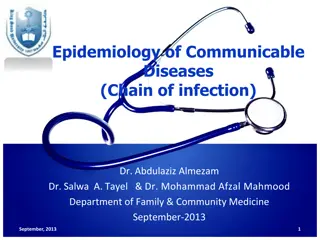Epidemiology of Communicable Diseases: Chain of Infection
This lecture discusses the transmission process of infectious diseases, types of reservoirs, carriers, zoonoses, modes of transmission, and factors affecting the spread of communicable diseases. It covers the cycle of infection, agent characteristics, infectivity, and pathogenicity, with examples to illustrate key concepts in epidemiology.
Download Presentation

Please find below an Image/Link to download the presentation.
The content on the website is provided AS IS for your information and personal use only. It may not be sold, licensed, or shared on other websites without obtaining consent from the author.If you encounter any issues during the download, it is possible that the publisher has removed the file from their server.
You are allowed to download the files provided on this website for personal or commercial use, subject to the condition that they are used lawfully. All files are the property of their respective owners.
The content on the website is provided AS IS for your information and personal use only. It may not be sold, licensed, or shared on other websites without obtaining consent from the author.
E N D
Presentation Transcript
Epidemiology of Communicable Diseases (Chain of infection) Dr. Salwa A. Tayel & Dr. Mohammad Afzal Mahmood Department of Family & Community Medicine September-2013 September, 2013 1
OBJECTIVES OF THE LECTURE By the end of this lecture you will be able to: Describe theprocess of infectious diseases transmission (Chain of infection) List the types of reservoir of infectious diseases of human Define a CARRIER and list its types. Define ZOONOSES and list examples. Identify the different MODE OF TRANSMISSION of the organisms from the reservoir to the susceptible host. 2 2 September, 2013
Cycle of infection 3 September, 2013
Cycle of infection A process that begins when an agent leaves its reservoir through a portal of exit, and is conveyed by some modeoftransmission, then enters through an appropriate portal of entry to infect a susceptible host. 4 September, 2013
Factors affecting perpetuation/spread of Communicable diseases The essential elements for Communicable Disease Transmission: 1. Presence of microbiological agent. 2. Presence of reservoir. 3. Portal of exit. 4. Mode of transmission. 5. Portal of entry (inlet). 6. Presence of susceptible host. 5 September, 2013
Agent Microorganisms are responsible for disease production (viruses, bacteria, protozoa, parasites, fungi,.. Agent characteristics that affect disease transmission: Infectivity Pathogenicity Virulence Antigenicity Toxicity, dose of inoculums, resistance strains, 6 September, 2013
Infectivity The ability of an agent to invade and multiply (produce infection) in a susceptible host. How to measure (Infectivity); ease & spread of infection? Secondary Attack Rate The proportion of exposed susceptible persons who become infected. sec of Number of ondary cases = 100 Secondary attack rate x Number susceptibl es Examples: High infectivity: Measles, Chickenpox Low infectivity: Leprosy 7 September, 2013
Pathogenicity Is the ability of the organisms to produce specific clinical reaction after infection Itrefers to the proportion of infected persons who develop clinical disease. Examples: High pathogenicity: Measles, Chickenpox (Class B) Low pathogenicity: Polio, Tuberculosis, Hepatitis A, Meningitis, AIDS (Class A) It can be measured by: Ratio of clinical to sub-clinical case = Clinical cases Subclinica l cases 8 September, 2013
Virulence The ability of an infectious agent to cause severe disease, measured as the proportion of persons with the disease who become severely ill or die. Examples: Rabies, Hemorrhagic fevers caused by Ebola and Murberg viruses. (Class C) Virulence is measured by: Case fatality rate Total number of disease a from deaths = Case fatality rate 100 x Total number of cases of that disease 9 September, 2013
Antigenicity (Immunogenicity) The ability of the organism to produce specific immunity (antibodies or antitoxin). It can be measured by: Second attack frequency: Second attacks are rare: measles, mumps and chickenpox. Re-infection occurs frequently: common cold, syphilis and gonorrhea. 10 September, 2013
2. Reservoir of infection The reservoir of an agent is the habitat in which an infectious agent normally lives, grows, and multiplies. Types of Reservoir Human reservoir Animal reservoir Non-living reservoir September, 2013 11
Human reservoirs Two types of human reservoirs exist: Case Carrier: A person that harbors the infectious agent for a disease and can transmit it to others, but does not demonstrate signs of the disease. Temporary OR Chronic (such as Salmonella typhi Carriers have no symptoms, not diagnosed, so can infect others, causing infection control difficult. September, 2013 12
Reservoirs Zoonoses: An infection or infectious disease transmissible under natural conditions from vertebrate animals to humans. >100 Zoonotic Diseases such as Brucellosis (sheep, goats and pigs), Bovine tuberculosis (cattle), Rabies (bats, dogs, and other mammals). Environmental reservoirs: For example: Soil may harbor spores that causes tetanus and anthrax. Pools of water are the primary reservoir of Legionnaires bacillus. 13 September, 2013
3. Portal of exit Portal of exit is the path by which an agent leaves the source host. E.g. Examples: Urinary tract Intestinal tract Respiratory tract Skin and mucous membrane Blood September, 2013 14
4. Modes of transmission Direct Indirect Direct Contact Vehicle borne Droplet spread Vector borne Contact with soil Airborne Inoculation into skin or mucosa Fomite-Borne Unclean hands and fingers Trans-placental (vertical) 15 September, 2013
Direct Transmission Direct modes: reservoir & susceptible host are physically present together resulting in immediate transfer of infectious agent: 1- Direct contact: e.g. Sexually Transmitted Infections, 2- Droplet infection: e.g. Sneezing leading to ARI 3-Contact with soil: e.g. Tetanus, hookworm larvae 4-Inoculation into skin or mucosa: e.g. Rabies, Hep B 5- Trans-placental: Mother to her foetus, e.g. HIV September, 2013 16
Indirect transmission 1- Vehicle-borne: The agent may multiply in the vehicle before transmission. FOOD (e.g. Hep A), WATER (e.g. Cholera), MILK (e.g. TB), BLOOD (e.g Hep B) 2- Vector-borne: arthropod or other living carrier e.g. Flies carrying Shigella, and Mosquito propagating malaria parasites 3- Airborne: e.g TB transmitted indirectly through airborne transmission, than directly through direct droplet spread. Legionnaires disease and fungal spores also spread through airborne transmission. September, 2013 17
Indirect transmission 4- Fomite-borne: e.g. clothes, cups, door handles, surgical dressings and instruments. Disease examples Hep A, Influenza, Eye infections 5- Unclean hands & fingers: causing, e.g., typhoid, staph. & strept. infection, hepatitis A September, 2013 18
5. Portal of entry An agent enters a susceptible host through a portal of entry. The portal of entry must provide access to tissues in which the agent can multiply or a toxin can act. Often, organisms use the same portal to enter a new host as that they use to exit the source host. September, 2013 19
6. Susceptible host Host that don't have resistance against a particular pathogenic agent (i.e. susceptible) is liable to contract the disease when exposed to such agent. Resistance: is total body mechanisms which interpose barriers to progression of invasion& or multiplication of infectious agent. Susceptibility depends on: Genetic factors Malnutrition, Alcoholism, Disease, Therapy which impairs the immune response (e.g. cortisone, cytotoxic drugs, ...) Acquired Immunity (natural/Artificial) September, 2013 20
Body defense mechanism against infection o Skin, Mucous membranes, Gastric acidity, Cilia in the respiratory tract, Cough reflex o Nonspecific immune response; phagocytes o Specific immune response. i.e protective antibodies that are directed against a specific agent. 21 September, 2013
Herd immunity It is the state of immunity of a group or a community. Also it is; The resistance of a group to invasion and spread of an infectious agent, based on the immunity of a high proportion of individual members of the group . 22 September, 2013
Factors Affecting Herd Immunity: The extent of coverage of the immunization program. The degree of resistance to infection afforded by the vaccine. Duration and degree of infectivity of the organism. Past experience with different infections. Overcrowding and environmental sanitation. 23 September, 2013
Reference books Reference books Principles of Epidemiology in Public Health Practice. Third Edition. An Introduction to Applied Epidemiology and Biostatistics. Centers for Disease Control and Prevention (CDC) Porta M. A dictionary of epidemiology. 5th Edition. Oxford, New York: Oxford University Press, 2008. Gordis L. Epidemiology. 4th edition. Philadelphia, Pennsylvania: Elsevier Science, 2008 Beaglehole R, Bonita R, Kjellstrom T. Basic epidemiology. 2nd edition. Geneva: World Health Organization, 2006 September, 2013 24
